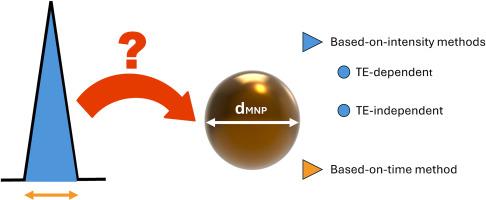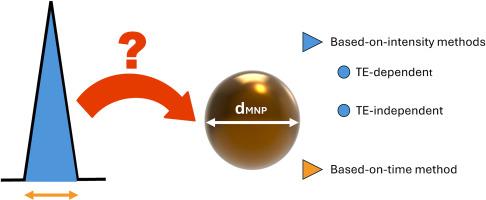Intensity- and time-based strategies for micro/nano-sizing via single-particle ICP-mass spectrometry: A comparative assessment using Au and SiO2 as model particles
IF 5.7
2区 化学
Q1 CHEMISTRY, ANALYTICAL
引用次数: 0
Abstract
Background
Single-particle ICP-mass spectrometry (SP-ICP-MS) is a powerful method for micro/nano-particle (MNP) sizing. Despite the outstanding evolution of the technique in the last decade, most studies still rely on traditional approaches based on (1) the use of integrated intensity as the analytical signal and (2) the calculation of the transport efficiency (TE). However, the increasing availability of MNP standards and advancements in hardware and software have unveiled new venues for MNP sizing, including TE-independent and time-based approaches. This work systematically examines these different methodologies to identify and summarize their strengths and weaknesses, thus helping to determine their preferred application areas.
Results
Different SP-ICP-MS methods for MNP sizing were assessed using AuNPs (20–70 nm) and SiO2MNPs (100–1000 nm). Among TE-dependent approaches, the particle frequency method was characterized by larger uncertainties than the particle size method. The results of the latter were dependent on the appropriate selection of the reference MNP, making the use of multiple reference MNPs recommended. TE-independent methods were based on external (linear and polynomial) calibrations and a relative approach. These methods exhibited the lowest uncertainties of all the strategies evaluated. External calibrations benefited from simpler calculations, but their application could be hindered by a lack of reference MNPs within the desired size range or by the need for interpolations outside the calibration range. Finally, transit time signals are directly proportional to the MNP size rather than its mass. The time-based method demonstrated adequate performance for sizing AuNPs but failed when sizing the largest SiO2MNPs (1000 nm).
Significance and novelty
This work provides further insights into the application of different SP-ICP-MS methodologies for MNP sizing. Both TE-independent approaches and the monitoring of the transit time as the analytical signal are underused strategies; in this context, a Python script was developed for accurate transit time measurement. After 20 years of development, a quantitative comparison of the different methodologies, including the most novel approaches, is deemed necessary for further growth on solid theoretical ground.


基于强度和时间的单颗粒 ICP 质谱仪微/纳米尺寸测定策略:以金和二氧化硅为模型颗粒的比较评估
背景单粒子 ICP 质谱法(SP-ICP-MS)是一种强大的微/纳米粒子(MNP)测定方法。尽管该技术在过去十年中取得了长足发展,但大多数研究仍依赖于基于以下两点的传统方法:(1) 使用积分强度作为分析信号;(2) 计算传输效率 (TE)。然而,随着 MNP 标准的不断增加以及硬件和软件的进步,为 MNP 的尺寸确定提供了新的途径,包括与 TE 无关的方法和基于时间的方法。结果使用 AuNPs(20 - 70 nm)和 SiO2MNPs(100 - 1000 nm)对不同的 SP-ICP-MS 方法进行了评估。在依赖 TE 的方法中,粒子频率法的不确定性大于粒度法。后者的结果取决于参考 MNP 的适当选择,因此建议使用多个参考 MNP。与 TE 无关的方法基于外部(线性和多项式)校准和相对方法。在所有评估方法中,这些方法的不确定性最低。外部校准的优点是计算简单,但由于缺乏所需尺寸范围内的参考 MNP 或需要在校准范围外进行内插,因此其应用可能会受到阻碍。最后,传输时间信号与 MNP 大小而非其质量成正比。基于时间的方法在测定 AuNPs 尺寸时表现出了足够的性能,但在测定最大的 SiO2MNPs(1000 nm)时却失败了。独立于 TE 的方法和监测作为分析信号的通过时间都是未充分利用的策略;在此背景下,我们开发了一个 Python 脚本,用于精确测量通过时间。经过 20 年的发展,我们认为有必要对不同的方法(包括最新颖的方法)进行定量比较,以便在坚实的理论基础上进一步发展。
本文章由计算机程序翻译,如有差异,请以英文原文为准。
求助全文
约1分钟内获得全文
求助全文
来源期刊

Analytica Chimica Acta
化学-分析化学
CiteScore
10.40
自引率
6.50%
发文量
1081
审稿时长
38 days
期刊介绍:
Analytica Chimica Acta has an open access mirror journal Analytica Chimica Acta: X, sharing the same aims and scope, editorial team, submission system and rigorous peer review.
Analytica Chimica Acta provides a forum for the rapid publication of original research, and critical, comprehensive reviews dealing with all aspects of fundamental and applied modern analytical chemistry. The journal welcomes the submission of research papers which report studies concerning the development of new and significant analytical methodologies. In determining the suitability of submitted articles for publication, particular scrutiny will be placed on the degree of novelty and impact of the research and the extent to which it adds to the existing body of knowledge in analytical chemistry.
 求助内容:
求助内容: 应助结果提醒方式:
应助结果提醒方式:


